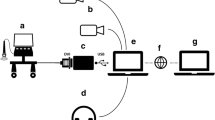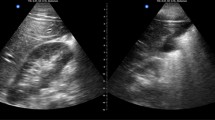Abstract
We investigated the feasibility of the clinical application of novice-practitioner-performed/offsite-mentor-guided ultrasonography for identifying the appendix. A randomized crossover study was conducted using a telesonography system that can transmit the ultrasound images displayed on the ultrasound monitor (ultrasound sequence video) and images showing the practitioner’s operations (background video) to a smartphone without any interruption in motion over a Long-Term Evolution (LTE) network. Thirty novice practitioners were randomly assigned to two groups. The subjects in group A (n = 15) performed ultrasonography for the identification of the appendix under mentoring by an onsite expert, whereas those in group B (n = 15) performed the same procedure under mentoring by an offsite expert. Each subject performed the procedure on three simulated patients. After a 4-week interval, they performed the procedure again under the other type of mentoring. A total of 90 ultrasound examinations were performed in each scenario. The primary outcomes were the success rate for identifying the appendix and the time required to identify the appendix. The success rates for identifying the appendix were 91.1 % (82/90) in onsite-mentored ultrasonography and 87.8 % (79/90) in offsite-mentored ultrasonography; both rates were high, and there was no significant difference (p = 0.468) between them. The time required in the case of offsite mentoring (median, 242.9 s; interquartile range (IQR), 238.2) was longer than that for onsite mentoring (median, 291.4 s; IQR, 200.9); however, the difference was not significant (p = 0.051). It appears that offsite mentoring can allow novice onsite practitioners to perform ultrasonography as effectively as they can under onsite mentoring, even for examinations that require proficiency in rather complex practices, such as identifying the appendix.


Similar content being viewed by others
Abbreviations
- LTE:
-
Long-Term Evolution
- IQR:
-
Interquartile range
- CT:
-
Computed tomography
- ED:
-
Emergency department
- SD:
-
Standard deviation
- SP:
-
Simulated patient
- KSUM:
-
Korean Society of Ultrasound in Medicine
- FPS:
-
Frames per second
- Mbps:
-
Megabit per second
- IP:
-
Internet protocol
- ACR:
-
American College of Radiology
- KB:
-
Kilobytes
- 3G:
-
3rd generation
References
Park JB, Choi HJ, Lee JH, Kang BS: An assessment of the iPad 2 as a CT teleradiology tool using brain CT with subtle intracranial hemorrhage under conventional illumination. J Digit Imaging 26:683–690, 2013
Choi HJ, Lee JH, Kang BS: Remote CT reading using an ultramobile PC and web-based remote viewing over a wireless network. J Telemed Telecare 18:26–31, 2012
Kim C, Kang BS, Choi HJ, et al: Nationwide online social networking for cardiovascular care in Korea using Facebook. J Am Med Inform Assoc 21:17–22, 2014
Kim C, Kang B, Choi HJ, Park JB: A feasibility study of real-time remote CT reading for suspected acute appendicitis using an iPhone. J Digit Imaging 28:399–406, 2015
Schlechtweg PM, Kammerer FJ, Seuss H, Uder M, Hammon M: Mobile image interpretation: diagnostic performance of CT exams displayed on a tablet computer in detecting abdominopelvic hemorrhage. J Digit Imaging 2015
Seong NJ, Kim B, Lee S, et al: Off-site smartphone reading of CT images for patients with inconclusive diagnoses of appendicitis from on-call radiologists. AJR Am J Roentgenol 203:3–9, 2014
Schwartz AB, Siddiqui G, Barbieri JS, et al: The accuracy of mobile teleradiology in the evaluation of chest X-rays. J Telemed Telecare 20:460–463, 2014
Kim C, Cha H, Kang BS, Choi HJ, Lim TH, Oh J: A feasibility study of smartphone-based telesonography for evaluating cardiac dynamic function and diagnosing acute appendicitis with control of the image quality of the transmitted videos. J Digit Imaging 2015
Ogedegbe C, Morchel H, Hazelwood V, Chaplin WF, Feldman J: Development and evaluation of a novel, real time mobile telesonography system in management of patients with abdominal trauma: study protocol. BMC Emerg Med 12:19, 2012
McBeth P, Crawford I, Tiruta C, et al: Help is in your pocket: the potential accuracy of smartphone- and laptop-based remotely guided resuscitative telesonography. Telemed J E Health 19:924–30, 2013
Biegler N, McBeth PB, Tiruta C, et al: The feasibility of nurse practitioner-performed, telementored lung telesonography with remote physician guidance—‘a remote virtual mentor.’. Crit Ultrasound J 5:5, 2013
Kim C, Kang BS, Choi HJ, Lim TH, Oh J, Chee Y: Clinical application of real-time tele-ultrasonography in diagnosing pediatric acute appendicitis in the ED. Am J Emerg Med 33:1354–1359, 2015
iTunes. Accessed January 5 2016. Available at http://www.apple.com/itunes
Huynh-Thu Q, Ghanbari M: Temporal aspect of perceived quality in mobile video broadcasting. IEEE Trans on Broadcast 54:641–651, 2008
Agboma F, Liotta A: Quality of experience management in mobile content delivery systems. Telecommun. Syst 49:85–98, 2012
Assembly ITU Radiocommunication. BT-500.13. Methodology for the subjective assessment of the quality of television pictures. International Telecommunication Union 2012
Kim SC, Kim BI: Analysis on subjective image quality assessments for smart phone/pad environments. Electronics and Telecommunications Trends 28:125–136, 2013
Puylaert JB: Ultrasonography of the acute abdomen: gastrointestinal conditions. Radiol Clin North Am 41:1227–1242, 2003
Ministry of Science, ICT and Future Planning of South Korea: The result of the quality of wireless communication services in Korea in 2015. Accessed on January 5 2016. Available at http://www.msip.go.kr/web/msipContents/contentsView.do?cateId=mssw311&artId=1233890&snsMId=NzM%3D&getServerPort=80&snsLinkUrl=%2Fweb%2FmsipContents%2FsnsView.do&getServerName=www.msip.go.kr Archived by WebCite® at http://www.webcitation.org/6eKM8BPbZ
Kim C, Kang B, Park JB, Ha YR: The use of clinician-performed ultrasonography to determine the treatment method for suspected paediatric appendicitis. Hong Kong J Emerg Med. 22:31–40, 2015
Acknowledgements
We thank Alpinion Medical Systems, which developed the tele-ultrasonography system in collaboration with us and provided this system to us free of charge for this study.
Author information
Authors and Affiliations
Corresponding author
Ethics declarations
Funding Source
No external funding was secured for this study.
Financial Disclosure
The authors have no financial relationships relevant to this article to disclose.
Conflict of Interest
The authors have no conflicts of interest to disclose.
Rights and permissions
About this article
Cite this article
Lee, Y., Kim, C., Choi, H.J. et al. A Feasibility Study of Telementoring for Identifying the Appendix Using Smartphone-Based Telesonography. J Digit Imaging 30, 148–155 (2017). https://doi.org/10.1007/s10278-016-9921-x
Published:
Issue Date:
DOI: https://doi.org/10.1007/s10278-016-9921-x




